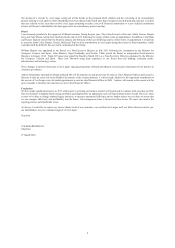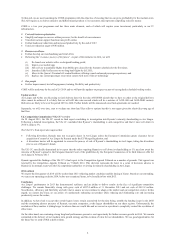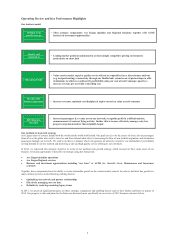Aer Lingus 2013 Annual Report Download - page 15
Download and view the complete annual report
Please find page 15 of the 2013 Aer Lingus annual report below. You can navigate through the pages in the report by either clicking on the pages listed below, or by using the keyword search tool below to find specific information within the annual report.
13
Altogether, these changes will add 24% to our long haul capacity (as measured by ASKs) in 2014. The expansion is being facilitated
through the ‘damp lease’ (i.e. the lessor provides the aircraft, flight crew, maintenance and insurance but we provide cabin crew) of three
Boeing 757 aircraft which are well suited for the profile of these routes. Two of the Boeing 757 aircraft will replace the A330 aircraft
currently based at Shannon and allow it to be deployed on the new Dublin to San Francisco service. The third Boeing 757 will be used to
operate the Dublin to Toronto service. Each of the Boeing aircraft will carry the Aer Lingus livery and be fitted out to offer our passengers
an experience consistent with that on our existing A330 transatlantic operation.
We expect total seat capacity on the Ireland – North Atlantic market to increase by approximately 16% in Summer 2014. However Aer
Lingus will account for almost 11% of this total increase via the capacity additions discussed above.
5. Ongoing evolution of our partnerships
2013 priority: Derive the greatest benefits from our open network architecture by expanding and deepening our existing portfolio of
partnerships, codeshare and interline agreements.
2013 progress achieved and relevant key performance indicators: We continued to build and develop our partnership arrangements with
the aim of providing our customers with access to more destinations on all continents. This approach allows us to extend our network reach
while managing risk and cost implications.
Our Aer Lingus Regional franchise partnership with Aer Arann continued to perform positively in 2013. Passengers carried on the franchise
routes increased by 10.1% to 1.1 million. Aer Lingus is also a partner in a leasing group which is in the late stages of acquiring eight ATR
72-600 aircraft which will be leased to Aer Arann. The franchise continues to be a key element of the integrated Aer Lingus network.
In 2013, approximately 27% (2012: 23%) of total long haul passenger traffic either connected from, or to, our partner airlines services. In
addition, we continued to grow interline revenues and passenger numbers by 17.6% and 6.0% respectively compared to 2012:
Interline traffic trends
2013
2012
2011
Interline revenue (€m)
77.4
65.8
60.5
Interline passengers (‘000)
882
832
789
If intra-Aer Lingus network transfer passengers are taken into account (including Aer Lingus Regional services), approximately 48% of our
total long haul passengers carried involved a connection.
During 2013, we secured the following new and strengthened partnership arrangements:
In February 2013, we announced a codeshare agreement with JetBlue Airways, expanding our pre-existing interline partnerships with
that airline at New York JFK and Boston Logan International. The codeshare commenced on 3 April 2013 which aligned with Aer
Lingus’ move from Terminal 4 in JFK to JetBlue’s Terminal 5. This agreement and move to JetBlue’s terminal at JFK strengthens our
relationship with this partner airline and provides significant benefits to our customers in accessing over 40 destinations across the US
from New York and Boston.
In March 2013, we announced an expansion of our code-share agreement with United Airlines, adding United’s services between
Washington and Dublin and Shannon and Chicago to the Aer Lingus booking engine and allowing United access to Aer Lingus
services from Dublin to Manchester to Birmingham.
2014 priority: Seek further opportunities to drive passenger volumes through our expanding partner network and to fully leverage the
advantages of our open network architecture. We will transfer our London Heathrow operations to that airport’s new Terminal 2 facility in
2014 where we will be one of the largest operators. We will share this terminal with 23 carriers from the Star Alliance. This proximity will
provide us with an opportunity to provide short haul feed services at both this terminal and other terminals in Heathrow. We will also
continue to build on and leverage our successful codeshare partnership for connecting traffic with British Airways. Heathrow remains a
focal point for both the mainline and business development elements of our medium term growth strategy.
6. Continued focus on cost management and operational efficiencies throughout our business
2013 priority: We remain very aware of the highly competitive environment in which Aer Lingus operates, especially as we compete with
one of Europe’s low cost leaders on the majority of our short haul routes ex-Ireland. For this reason, we continued to pursue cost reduction
opportunities and operational efficiencies across the Aer Lingus business despite the formal end of the Greenfield programme at the start of
2013.
2013 business outcomes and relevant key performance indicators: In 2013, we continued to experience price inflation in relatively non-
controllable costs such as airport and enroute charges (0.8%). Furthermore, the positive effect of currency hedging activity on our income
statement was lower than in previous years as newer hedge contracts are executed at rates which are less favourable than in the past. In this
context, we continued to focus attention on reducing, and where possible, eliminating controllable costs from the business.
A key 2013 initiative was the announcement in April 2013 of a voluntary severance programme (“VSP”) aimed at reducing headcount
across the Group by 100 full time equivalents. The number of staff who expressed an interest in the programme exceeded this target.
However, many chose not to commit to the VSP due to delays in achieving resolution of the IASS funding situation leading to uncertainty
about their future pension benefits. This had the effect of slowing the process of securing staff exits. A total of 124 staff have agreed to leave
under the VSP and at 31 December 2013, 119 staff had left Aer Lingus under the VSP. Due to the back-ended profile of VSP exits in 2013,
the full year benefit of these exits will be realised in 2014 and subsequent years. The total cost of the VSP was €8.9 million and the annual
employment costs of those who left was €5.3 million.
























